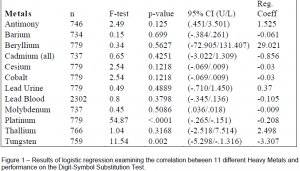Parker Woody and Professor Dawson Hedges, Department of Psychology and the Neuroscience Center
Heavy metals in the environment are a serious concern. One of the most widely known and studied neurotoxins is lead. For many years it was put into gasoline and paint in the US until it was discovered that it lead to developmental defects and affected cognitive functioning. There is a concern that other heavy metals could have adverse effects as well. Much research has focused on exposure to heavy metals in those exposed to abnormally high levels, such as those found in occupational exposures. Very little has been done examining heavy metal levels in the body such as those that might be found in the general population. According to the Fourth National Report on Human Exposure to Environmental Chemicals published in 2009, the adverse health affects of many heavy metals at low concentrations is unknown.
Because little in known about the cognitive effects of heavy metals from environmental exposure, We investigated the association between levels of eleven heavy metals in the blood and cognitive function in older adults as measured by the Digit-Symbol Substitution Test (DSST). The DSST requires subjects to draw a symbol associated with a particular number from presented number-symbol pairs. The score is the maximum number of symbols correctly drawn within 2 minutes (Department of Health, 2005). We hypothesized s that there would be a negative correlation between the amount heavy-metal concentration in the blood/urine and performance on the DSST. We examined antimony, barium, beryllium, cadmium, cesium, cobalt, lead, molybdenum, platinum, thallium, and tungsten.
For our analysis, we used data from the National Health and Nutrition Examination Survey (NHANES). The NHANES is a health survey sponsored by the US government through the Center for Disease Control. It uses written tests, exams, interviews, and samples from counties around the nation and can be weighted to represent the entire United States population. We used the statistical program SAS to perform linear regressions using the heavy metal data and cognitive data from the DSST for four years from 1999-2002.
We found a significant correlation with two of the eleven metals that we tested: platinum(β = – .208, p <.0001) and tungsten (β = -3.307, p = .002). The association we found with tungsten is consistent with previous findings showing low and high doses of tungsten had neurobehavioral consequences in adult female rats and their progeny (McKinturf et al., 2008). Adult female rats in the low-dose group showed increased locomotion, while those in the high-dose groups showed increased stereotypical movements. In addition, pups in the high-dose group showed an increase in distress vocalizations. These findings indicate neurobehavioral effects in both prenatal and postnatal exposure to low tungsten levels and suggest non-occupational exposures to certain metals may impair cognitive function in animal models.
There were several challenges that had to be overcome in order to do this research project. The first was learning how to use SAS. For my part, though I am somewhat familiar with programming, I had never done statistical programming before. It was also necessary to become familiar with the complex system of weights which NHANES uses to account for their sampling strategy. Some groups are oversampled in order to make sure that for certain minority groups there is enough data to create reliable results. Also certain tests, such as the evaluation of heavy metals in the urine, are only performed on subsamples of the population and so a different set must be used when working with these groups.
Our findings support some of those found in previously published literature and indicate that it might be beneficial to investigate platinum and tungsten further to verify the results that we have found. We are currently working on writing a scientific paper to publish these results. As a result of our investigation, we also found a correlation between poverty income ratio and DSST scores and are going to analyze and publish those results separately. 
References
- Department of Health and Human Services, Center for Disease Control and Prevention. (2005). 1999-2000 Data Documentation, Codebook, and Frequencies Hyattsville, Maryland: Retrieved from http://www.cdc.gov/nchs/nhanes/nhanes1999-2000/CFQ.htm
- McInturf, S.M., Bekkedal, M., Wilfong, E., Arfsten, D., & Gunasekar, P.G. (2008). Neurobehavioral effects of sodium tungstate exposure on rats and their progeny. Neurotoxicology and Teratology, 30(6),
- Department of Health and Human Services, Center for Disease Control and Prevention. (2009). Fourth national report on human exposure to environmental chemicals Retrieved from http://www.cdc.gov/exposurereport
